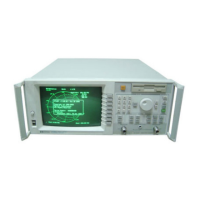I
-
Measuring Group Delay
The phase linearity of many devices is specified in terms of group or envelope
delay. This is especially true of telecommunications components and systems
where phase distortion is critical.
Group delay is a measure of transit time through the DUT as a function of
frequency. It is approximated by:
-Ati
@f
X360)
where
Aq5
is the phase difference between two adjacent frequencies
Af.
The quantity
Af
is commonly referred to as the aperture. The minimum
aperture is equal to the analyzer’s frequency span divided by the number of
points minus one, and can be entered as a frequency or a percent of span. lb
measure group delay correctly, the phase difference at a specific aperture
must be less than 180 degrees, satisfying the following relationship:
approximate
DUT
delay
<
number of points
-
1
2(frequency
span)
If this relationship is not satisfied, incorrect measurements will occur,
since the measurement of the phase difference at adjacent points will be
undersampled.
This section uses an example measurement to describe how to calibrate
and make a basic phase-derived delay (group delay) measurement. In this
example, a bandpass filter like the one that was shipped with your network
analyzer is used.
NOTE
Phase-derived delay cannot be used to measure frequency translating devices. Use AM delay (Option
1DA
or
1DB)
to measure frequency translating devices.
3-49
I-

